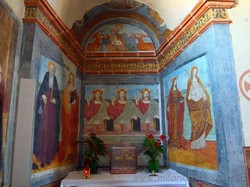|
Benna (Biella)- Church of San Pietro
|
|
|
Show to visit in the Biella area: |
 The parish Church of San Pietro was built in the sixteenth century in place of an older church. The façade was completed only in 1684, and the bell tower dates back to the eighteenth century. In 1797 there were renovations and the main portal was built. The parish Church of San Pietro was built in the sixteenth century in place of an older church. The façade was completed only in 1684, and the bell tower dates back to the eighteenth century. In 1797 there were renovations and the main portal was built.
The small size and its sobriety tend to hide its Renaissance origin, yet on the whole, the church can be described as a small version of the much larger and famous Basilica of San Sebastiano in Biella. In common the two churches also have the client of their construction, Sebastiano Ferrero.
The exterior of the church is very simple, with a structure in exposed brick apart from the facade and almost total absence of decorations. At the rear it is barely recognizable as a church, with the deep rectangular central apse, with rectangular totally simple windows placed at various heights, that protrudes so much that it looks like a house built against the back of the church.
The façade is therefore the only plastered part. It is divided vertically by pilasters and horizontally by cornices. The only decorations are two monochrome coats of arms within ovals above the main entrance and four small obelisks at the apex in correspondence of the pilasters. Furthermore there are three round windows, a larger one in the center and two smaller ones laterally in lower position.
The interior comprehends three naves separated by granite columns supporting arches underlined by terracotta cornices. A double horizontal terracotta frame runs horizontally along all the walls, interrupted only at the back of the apse.
Main nave, presbytery and transept are barrel-covered and are much higher than the side aisles, equipped with cross vaults.
The presbytery and chorus complex is very deep. The entire length of the walls is occupied, in its lower part, by the carved wooden choir stalls, sober but nevertheless not without solemnity.
The main altar, made of stone, is the result of a recent assembly of antique pieces.
The entrance to the presbytery is dominated by the carved, painted and gilded wooden architrave (Fig. 5) on which a large crucifix, a Madonna and a St. John Baptist are placed, all in polychrome wood. The first is from the seventeenth century and comes from the Church of San Germano in Tollegno, the others are from the eighteenth century and come from the Canavese area. The architrave was put in place in the 70s of the last century.
The church has no side chapels. There are two chapels at the head of the two side aisles, both originally completely frescoed.
The right chapel (Fig. 3) saw in 1933 the demolition of the eighteenth-century baroque altar and the recovery of the original frescoes made by Gaspare da Ponderano of the early sixteenth century. On the back wall the Madonna of Mercy or of the Graces, represented with a popular taste, has a mantle supported by four angels. Under it, women and men are gathered in prayer in the typical costumes of the time. On the side walls are instead visible St. John the Baptist, St. Mary Magdalene and St. Peter and a holy warrior (St. Defendant?). In the upper lunette there is Christ dead and risen. On the vault, finally, a simulation of coffered ceiling.
The chapel is currently used as a baptistery.
In the chapel at the bottom of the left aisle (larger picture), dated 1535 and whose frescoes (also these rediscovered after the demolition of an eighteenth-century altar) are attributed to the school of Defendente Ferrari (1497-1531), there is instead a Trinity of considerable interest because of the unorthodox iconography. In fact, it is represented through three identical figures sitting behind a table. Each one has a chalice and a host in front of him, with the right hand blessing and the left resting on a book. On the side walls there are the Saints Anthony Abate and Peter (left wall) and the Saints Lucy and Apollonia (right wall). Between the two terracotta frames there is a beautiful Renaissance frieze. In the lunette a Madonna with Child and Saints and the date of realization. Finally, on the vault, remains of a Christ in almond surrounded by the symbols of the evangelists.
Also worthy of note is the ancient damask-painted canteen.
On the left wall, in continuity with the chapel just described, other fragments of frescoes are visible (Fig. 4) by Gaspare da Ponderano of the first half of the sixteenth century, in which the Annunciation, the Saints Nicolò from Tolentino, Rocco, Fabiano and Sebastiano. It should be noted that all the frescoes of the church, apart from this last ones, although renaissance as period of creation, are still Gothic in style.
Also noteworthy is the canvas in the center of the counterfacade, dedicated to Saint Peter and work of Giuseppe Maria Aureggio Termine of 1773, and, kept in the sacristy, the wooden sculptural group dedicated to the baptism of Christ and work of Pietro Antonio Serpentiere of 1808.
Categories: Places of historical value of artistic value
Piazza S. Pietro, 3, 13871 Benna BI |
Church of San Pietro: Further pictures in the section Photography |